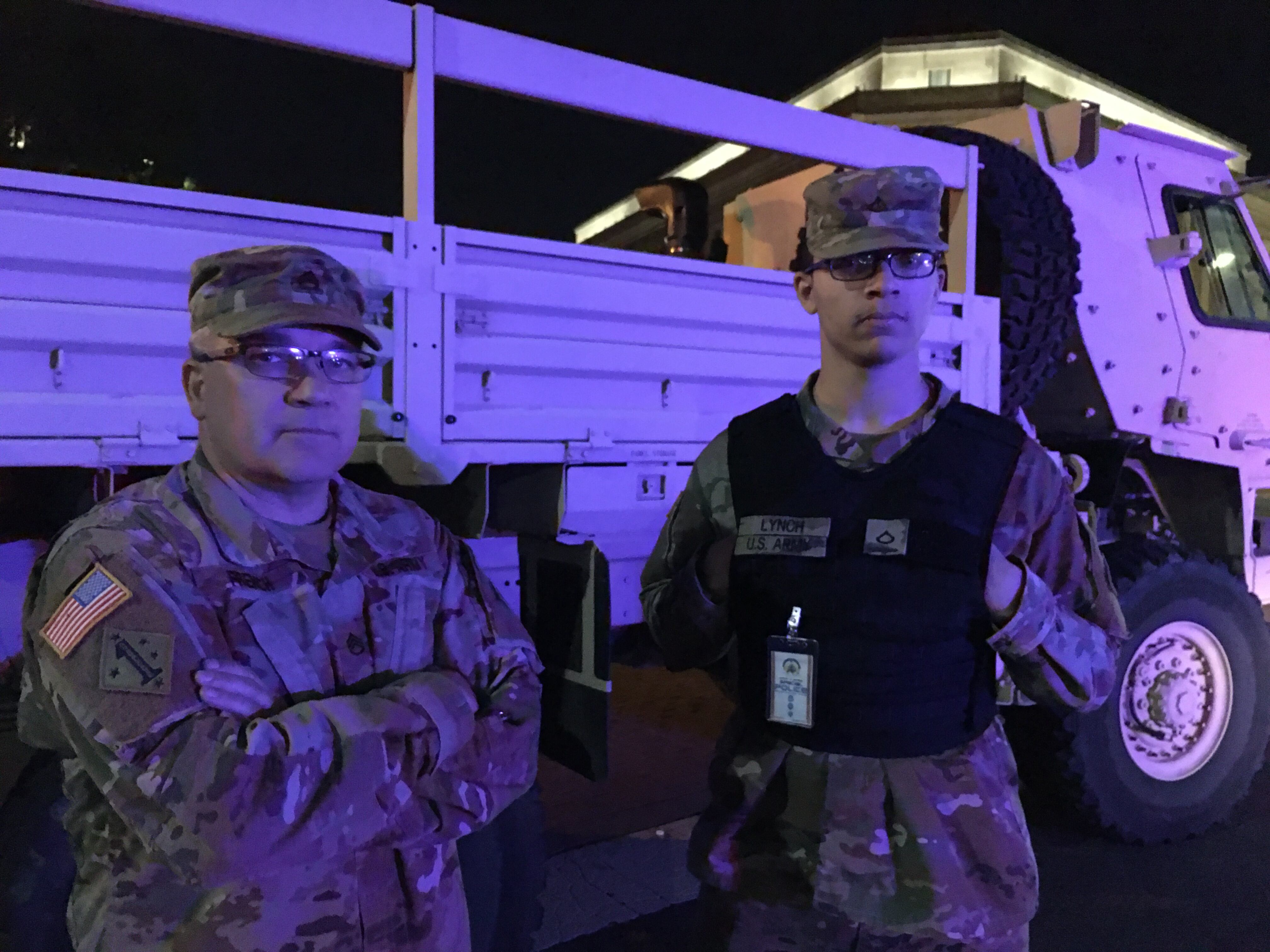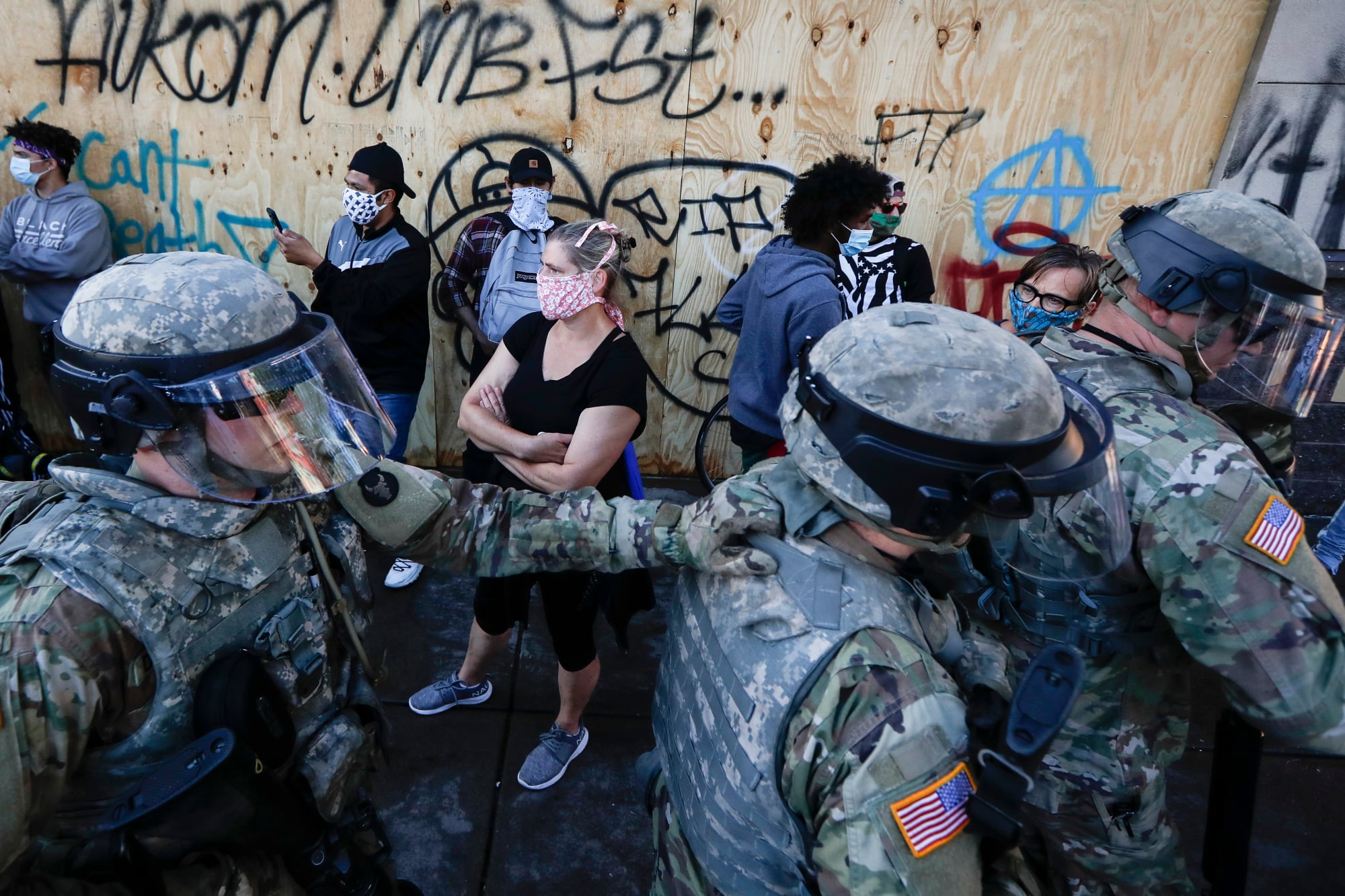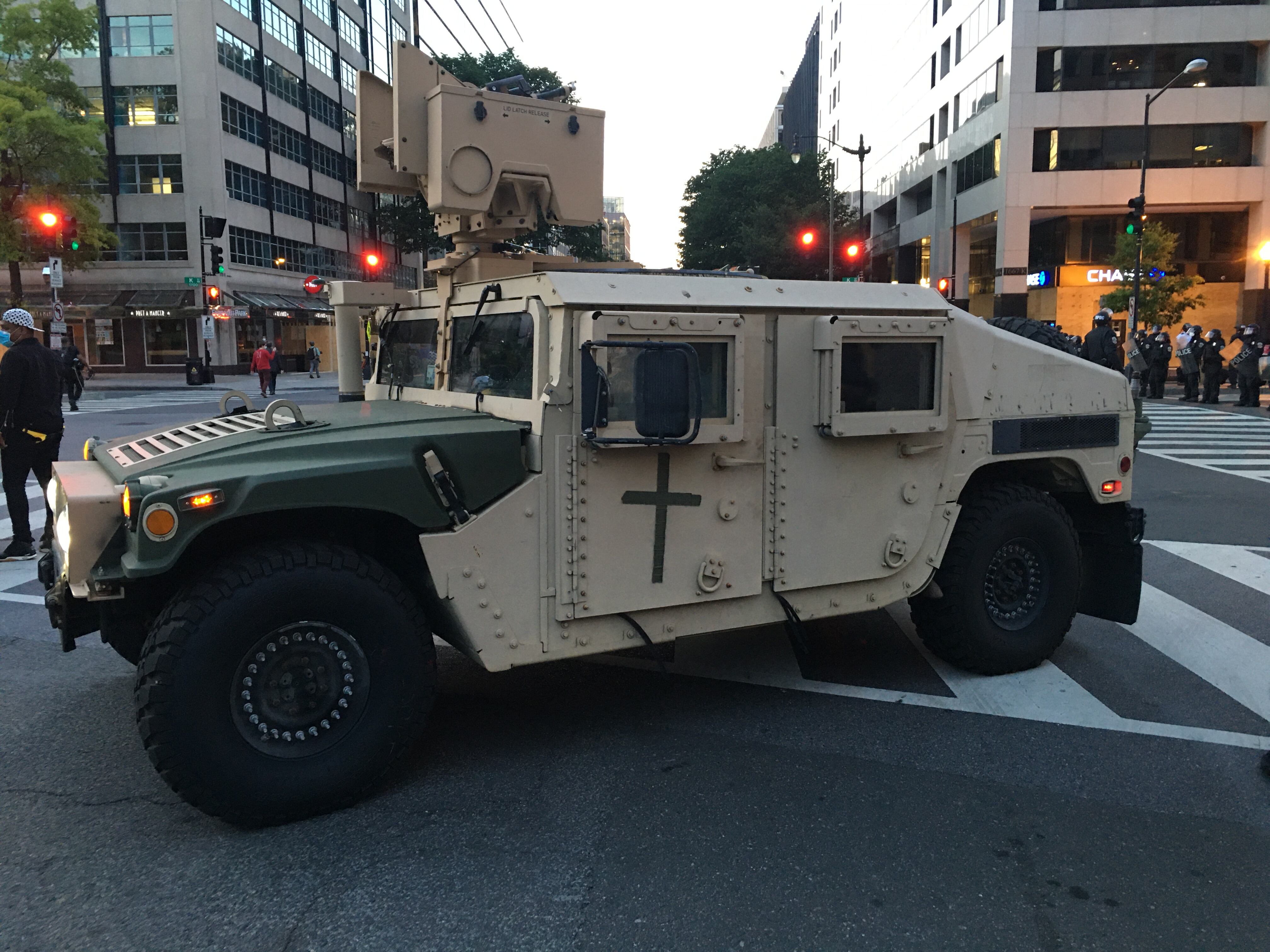Hours after the sometimes chaotic protesting died down, two soldiers with the D.C. National Guard kept watch at the mostly calm corner of Pennsylvania Avenue and 7th Street N.W.
It was about 11:30 p.m. at the midpoint between the White House and the Capitol building and Staff Sgt. Jeremy French and Pfc. Rich Lynch were stationed to make sure no vehicles headed northwest on Pennsylvania Ave.
They were part of the largest domestic mobilization of Guard troops in the nation’s history, with more than 17,000 activated for civil unrest duties and about 45,000 more to help with the response to the coronavirus pandemic.
The D.C. troops were armed only with defensive weapons, Guard officials said. Rubber bullets, shields and batons. They were not assigned to arrest or detain anyone, and the use of proportional force was only allowed if their lives were endangered.
“It kind of makes sense to me that they would chose Washington, D.C., to come and be heard,” French said of the thousands of people who flooded into town to protest the death of George Floyd, a black man who prosecutors say was murdered by a Minneapolis police officer who had his knee on a restrained Floyd’s throat.
“That’s because right there in the background is the U.S. Capitol,” said French, nodding his head toward the gleaming domed structure four blocks to the southeast. “Those are the people who make the laws. So if you had something you wanted to be able to have your voice heard about, to make an impact and maybe change, that would be the place to do it. So I think this is the appropriate place to be heard.”

French and Lynch were pulling duty several hours after President Donald Trump announced his intentions to call in active duty troops to respond to the growing unrest that is sweeping the nation, resulting in several deaths, massive destruction and hundreds of thousands of people expressing their outrage over racial injustice.
French avoided politics, saying his perspective is just from his position at the intersection of 7th and Pennsylvania Avenue. But he said it is local law enforcement, not the military, that is best suited to coping with the looting, burning and violence that has erupted along with peaceful protests.
“We’ve seen some protesters come up and down, back and forth, but it seems like it’s been pretty peaceful,” said French, 49, who previously served with the Marines in both the first Gulf War and Afghanistan and later as a contractor working in Afghanistan.
“I’m definitely not an expert on civil disturbances,” he said, “so it looks to me like the D.C. Metro Police are doing a pretty good job of controlling the situation and with us in general support, maybe this is enough. I’m not really sure if you brought more military in that they would be able to do anything any different.”
The D.C. Metro Police “are specially trained for this mission,” he said.
As he spoke, several police cars speed north, lights flashing, down 7th Avenue toward some unknown event.
“Here in the nation’s capital, protest is not a new thing,” said French. “Neither are large activities like Fourth of July celebrations, parades, things of that nature. So I believe protest activity is something better left to the experts and I would say the experts are definitely D.C. Metro Police.
“The military is trained in crowd-control techniques and tactics, however that is with more of a DoD type of flair in a deployed environment,” said French. “But this is the U.S. It is a little bit different here.”
RELATED

Protecting Rights
Both French and Lynch said they felt their mission was essential to upholding the constitutional rights of free assembly.
Lynch, the private first class, spent half of his 20 years as a resident of the District.
“I’m just doing my job,” he said. “I know a lot about this area and how these people feel about the situations going on, but I am just doing what I am supposed to.”
And that’s making sure motorists don’t drive toward the White House, or interfere with those who are protesting. Helping to block the street was a tan light medium tactical vehicle from the D.C. National Guard motor pool, parked in the middle of Pennsylvania Avenue.
“The mission is to separate the good protesters and then the rioters and looters,” said Lynch. “You kind of have to draw the line between which is which.
How do you do that?
“Just see the actions they take, they speak louder than words,” he said. “If they are throwing bricks at you, they are not there to be peaceful. If they are just holding up signs and not causing any violence, why should we use violence, you know?"

Lynch said that he’s had positive interactions with most of those who have taken to the streets.
“People are now starting to associate our uniforms with police uniforms — and that’s the thing: We are not police,” he said, smiling. “We are not here to arrest you for jaywalking or smoking whatever you want to smoke. We are here to just assist.”
French said that Washington “is near and dear to my heart.
“It was my first duty station in the Marine Corps,” he said.” I was stationed at Marine Barracks 8th and I back in 1989 so that’s 30 years ago. ...my civilian job was in Washington, D.C. “
As a D.C. Guardsman, French said “we are out here in general support of the D.C. Metro Police to help ensure public safety for everybody, provide the opportunity for protesters to assemble peacefully and try to reduce the amount of the unlawful activity that is going on after hours in certain areas being done by certain people. So I think it is a pretty important job for all of the Americans who were out here, to give people the opportunity to express their First Amendment rights but within the legal boundary of the rule of law.”
For French, Monday was his first night on the streets during the protests.
“I’ve had a very positive experience,” he said. “Been treated well by passers by and the like. I’ve had several conversations with folks, so I have been treated really well.”
Esper and Milley visit troops after church tumult
While it was calm in Washington near midnight Monday, several hours earlier the scene near the White House at St. John’s Episcopal Church at 15th and H streets NW was bedlam.
Those protesting were hit with tear gas as Trump and a coterie of officials, including Defense Secretary Mark Esper and Joint Chiefs Chairman Army Gen. Mark Milley made their way to the church.
Law enforcement officers were aggressively forcing the protesters back, firing tear gas and deploying flash bangs into the crowd to disperse them from the park for seemingly no reason. It was a jarring scene as police in the nation’s capital forcefully cleared young men and women gathered legally in a public park on a sunny evening, all of it on live television.
With smoke still wafting and isolated tussles continuing in the crowd, Trump emerged in the Rose Garden for a dramatic split-screen of his own creation.
“I am your president of law and order and an ally of all peaceful protesters," he declared, before demanding that governors across the nation deploy the National Guard “in sufficient numbers that we dominate the streets.” And Trump warned that, if the governors refused, he would deploy the United States military “and quickly solve the problem for them.”
As an additional show of force, Trump announced he was deploying even more of the military to Washington, giving it the feel of an armed, locked-down city after days of violent clashes, arson and looting.
“As we speak I am dispatching thousands and thousands of heavily armed soldiers," he said, as explosions rang out in the background. “We are putting everybody on warning.”
Hours later, Esper and Milley, along with Army Chief of Staff, Gen. James McConville and Army Secretary Ryan McCarthy arrived at 15th and K streets NW to talk with D.C. Guardsmen.
“Thanks for being out here,” said Esper, his arms crossed, to one of the soldiers. “Thanks for your service. You want to go on active duty?”
Esper did not take questions from a small group of reporters on the scene. But Milley spoke for about half a minute.
Those gathered, he said, can “protest, but to protest peacefully.
The Pentagon’s top officer said his message on this night was to “allow freedom to assemble, freedom of speech, that’s perfectly fine. We support that. We took an oath of allegiance to the Constitution of the United States of America to do that. And to protect everyone’s rights. And that’s what we do. We’ve got the D.C. National Guard out here and I was just checking to see how well they are doing, that’s all.”
Just before midnight, the young PFC who spent half his life as a resident of the District reflected on an historic turn of events in a city that has been burned and looted over days of protest both peaceful and violent.
“I walked up and down these streets as a civilian before I joined the Guard,” said Pfc. Rich Lynch. “And to see the way it looks now, it’s crazy.”
This story contains information from the Associated Press
Howard Altman is an award-winning editor and reporter who was previously the military reporter for the Tampa Bay Times and before that the Tampa Tribune, where he covered USCENTCOM, USSOCOM and SOF writ large among many other topics.



